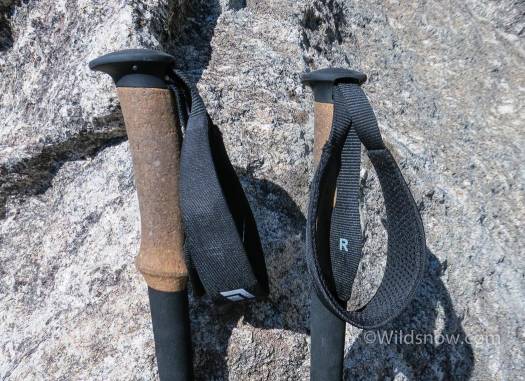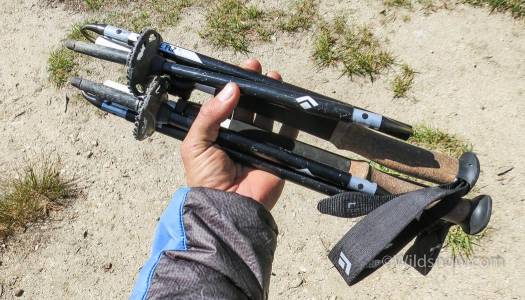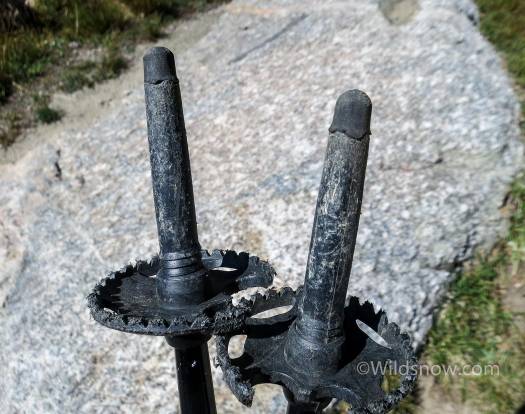Knees top my list of poorly designed body parts — right up there with wisdom teeth and my appendix. Even though I’m young, after over 20 years of backcountry skiing and hiking, my knees are starting to show some wear. Unfortunately many of the sports I love require lots of hiking in alpine terrain. Hiking downhill is one of my knees’, and my own, least favorite activities.
Using ski poles for hiking takes a great deal of pressure off the knees, especially on the descent. So if the day involves skiing and hiking, I use the poles for both. However, I often didn’t bring ski poles for summer climbing trips. Time to change that!

The grips for Black Diamond FLZ poles are super comfy. The wrist strap is simple and light. All wrist straps should be like these.
Black Diamond came out with their innovative Z-pole technology a few years ago. While many of my split-boarding friends use them, I haven’t had the chance to try any. I settled on a pair of BD Alpine FLZ poles. They aren’t the lightest or smallest in the line, but they keep the weight and size fairly low while still being strong, stiff, and adjustable. I do not find poles that break down small very useful for skiing or normal hiking. However, for climbing and hiking the small packed size is ideal.
The Z-poles come apart in sections like a tent pole, as opposed to traditional telescoping trekking poles. This allows the poles to split into more sections, as well as eliminating some weight. The Alpine FLZ poles break down into three sections, and pack down to 15 inches (40cm). The medium size, which I have, weighs 18.7 ounces, 528 grams (verified on my postal scale). The poles feature a mostly cork grip, with a small rubber top to increase durability. They come with padded wrist straps as well, and two sets of baskets: a set of powder baskets for winter use, and a set of small baskets for summer use. They also have a set of small rubber tips that can be screwed into the tip in place of the traditional carbide metal tip.
I began using the poles about a month ago. First test was a climbing trip into the Wind Rivers, Wyoming, (story here ). My pack weighed a ton, and the poles were a welcome help. Since then, I’ve used them on a quite a few other trips, both day jaunts and overnights. I’ve also forgotten them a few times, which only cemented how nice it is to use a pair of trekking poles.
BD FLZ poles are aluminum and adjustable, which makes them a bit heavier than some of the other poles in Black Diamond’s line. I chose them as they are a bit stronger than the lighter options. Although I’ve put them through some abuse, they have held up well. I’ve carried some heavy loads, and descended some steep trails. The only evidence of wear is the a bit on the rubber tips, and a few small chunks taken out of the cork handles.
Even though the poles aren’t the smallest, I’ve never had any that packed down quite this small. It’s nice to be able to collapse them and be low profile on my pack, especially for scrambling. Also, the small size means they’re often in the trunk of my car, ready for any last-minute hikes.
Again, FLZ poles have limited length adjustability, but I have found it to be sufficient. On some steeper descents I’ve maxed out the length, and I’ve gotten close to the shortest setting on some deeply rutted trails. One nice feature of the z-pole system is that the length adjustment is separate from the collapsing mechanism. This means that when you assemble them, they are already set at the same length you used the last time. However, if you set the poles to the shortest length, they do fold down slightly shorter.
I’ve only used the FLZ poles with the smaller trekking baskets, as well as the rubber tips (as opposed to carbide steel). BD’s rubber tips aren’t the bulkier rubber trekking pole tips that fit over the normal ski pole tips. Instead, they screw into the end of the pole, entirely replacing the carbide tip. These seem to work much better than the larger rubber tips which pop off and get snagged on roots and rocks. I was skeptical the rubber tips would wear down quickly, or become unscrewed, but neither has happened. Unfortunately the tips can’t be swapped out by hand (you need pliers), and they’re small enough that I’m sure I’d lose them if I tried to bring both sets on a trip. I plan on leaving the rubber tips installed for most of my use.
The major con with these poles is their weight; they’re heavier than many of BD’s other Z-poles, especially the non-adjustable carbon options. BD’s Distance carbon poles, at 10 oz, are almost half the weight. However, I find it a worthy trade for the extra strength and adjustability. The slightly heavier cork grips are also nice on the hands. For whatever reason, cork grips tend to be super comfy, especially on long days. Also, they aren’t sticky when they are hot, and don’t get slippery when they are wet, two disadvantages of rubber grips. Foam grips approach the comfort of cork grips, but I’ve found them to be more prone to giving blisters. One question, could you used these as ski poles? They are strong enough, and have adjustability, so they would likely work for winter sports. I look forward to testing that option. Soon.
Black Diamond’s Z-pole system is the best stowage I’ve seen. Overall, these trekking poles are a stellar option if you’re looking for a solid, lightweight, and fairly inexpensive set of sticks.
Save your knees and get a pair of Black Diamond trekking poles here.
Louie Dawson earned his Bachelor Degree in Industrial Design from Western Washington University in 2014. When he’s not skiing Mount Baker or somewhere equally as snowy, he’s thinking about new products to make ski mountaineering more fun and safe.



